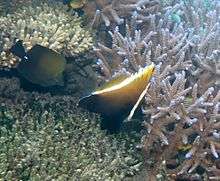Heniochus varius
Heniochus varius, the horned bannerfish, is a marine fish belonging to the family Chaetodontidae, native from the central Indo-Pacific area.
| Heniochus varius | |
|---|---|
 | |
| Scientific classification | |
| Kingdom: | Animalia |
| Phylum: | Chordata |
| Class: | Actinopterygii |
| Order: | Perciformes |
| Family: | Chaetodontidae |
| Genus: | Heniochus |
| Species: | H. varius |
| Binomial name | |
| Heniochus varius (Cuvier, 1829) | |
Description
The horned bannerfish is a small-sized fish that can reach a maximum length of 19 cm.[2]
Its body is compressed laterally, with the first rays of its dorsal fin stretched in short feather-like filaments. The background color is chocolate to black with two white bands.
The two white bands are slightly oblique, their run is convergent but they are not intersecting. The first one starts the anterior ventral area, passes between the eyes and the pectoral fin's shoulder and ends with the first rays of the dorsal fin. The head is black to chocolate and this dark area includes the mouth, the eyes, the little horn between the eyes and the frontal growth. The space between the horn and the growth gives the impression that the profile of its forehead is concave. The second white band begins from the base of caudal peduncle and move towards the center of the dorsal fin. The area between the two white bands is black on the ventral part and shades gradually to chocolate color when reaching the dorsal fin. A latter light chocolate band extends diagonally just beyond the second white band. The pectoral and the caudal fins are translucent.
The horned bannerfish can be confused with the very similar phantom bannerfish, Heniochus pleurotaenia. The main difference is that the horned bannerfish does not have the reversed "v" pattern on its sides. Juveniles, which lack the white insert for the phantom bannerfish, can be distinguished by the shorter extension of the first rays of the dorsal fin.
Distribution and habitat
The horned bannerfish is widespread throughout the tropical and subtropical waters of the central Indo-Pacific from Indonesia to Polynesia and from south Japan to New-Caledonia.[1][3]
It inhabits areas rich in coral in shallow lagoons and external reef slopes from the surface to a depth of 30 meters.[4]
Biology
The horned bannerfish is a solitary fish but it can live in pairs or even in small groups.[5] Its diet is varied and consists of coral polyps and various benthic invertebrates.[3]
Conservation status
In some geographic areas, the horned bannerfish is occasionally harvested for the aquarium trade, however the species does not currently appear threatened is listed as Least Concern (LC) by the IUCN.[1]
References
- Rocha, L.A., Allen, G., Myers, R. & Pratchett, M. 2010. Heniochus varius. The IUCN Red List of Threatened Species 2010: e.T165652A6081573. . Downloaded on 11 September 2015.
- Lieske & Myers (2009). Coral reef fishes. Princeton University Press. ISBN 9780691089959.
- Lieske & Myers,Coral reef fishes,Princeton University Press, 2009, ISBN 9780691089959
- Allen, G.R. and M.V. Erdmann, 2012. Reef fishes of the East Indies. Perth, Australia: University of Hawai'i Press, Volumes I-III. Tropical Reef Research.
- Rudie Kuiter, “Chaetodontidae & Microcanthidae”, Aquatic Photographics, 2004, ISBN 0953909735
External links
- Photos of Heniochus varius on Sealife Collection
| Wikispecies has information related to Heniochus varius |
